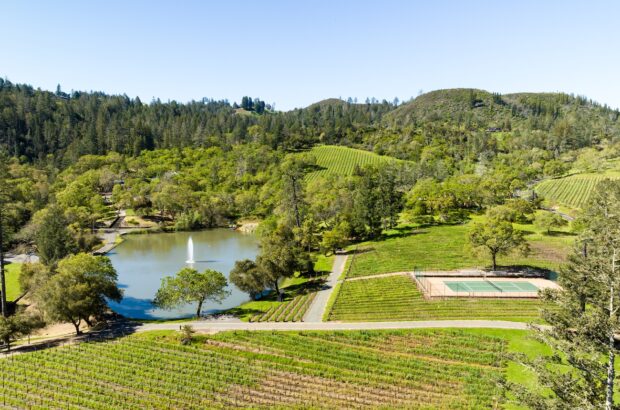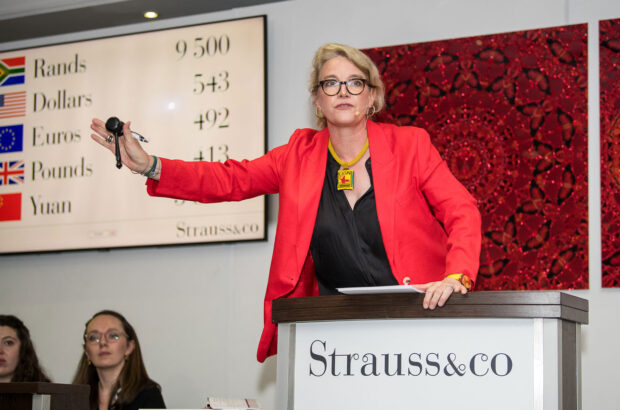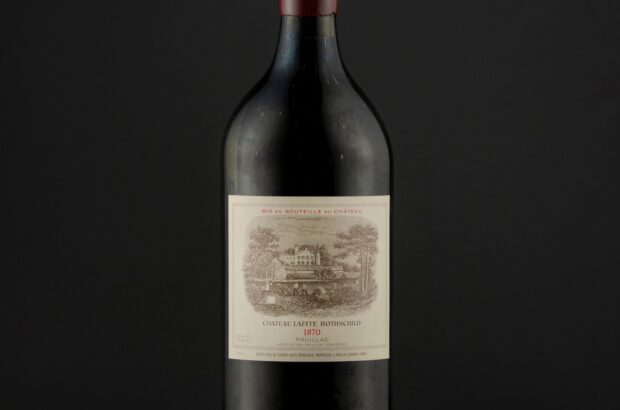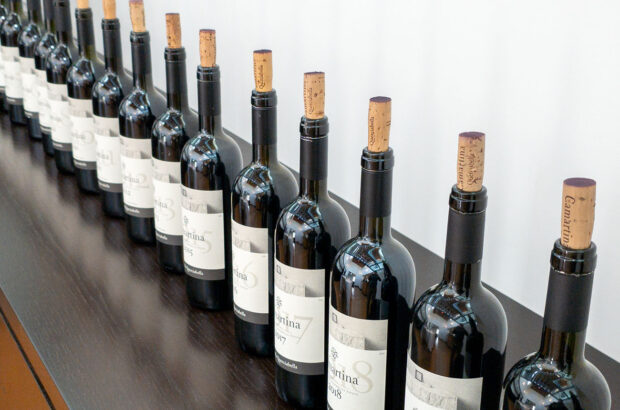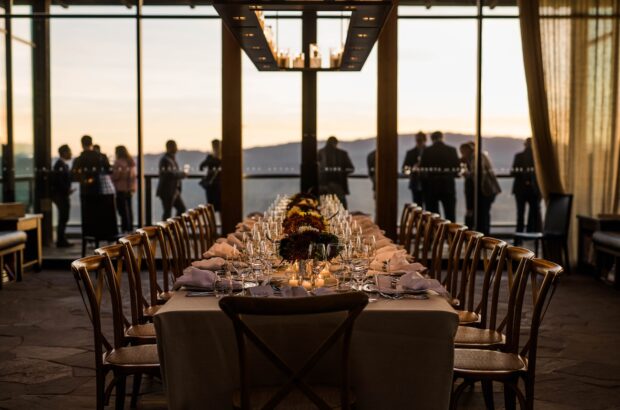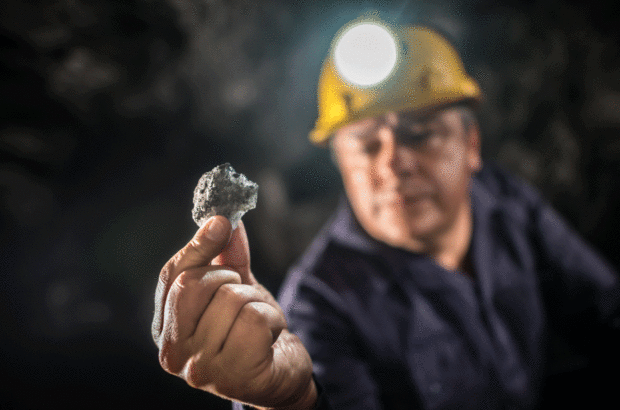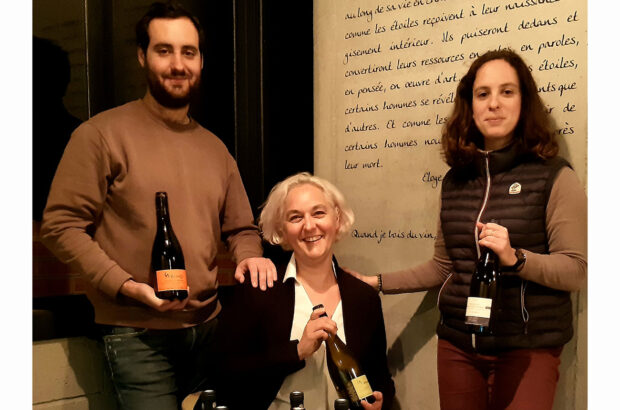Tuscany’s Montalcino region is shaped like a four-sided pyramid,whose well-sheltered, well-drained topography is bright, breezy and especially vine friendly. It’s also an incredibly beautiful place to live, sparsely populated and far from motorways and heavy industry.
Half of Montalcino’s land is wild, either grassland or oak and chestnut forests teeming with wild boar and roebuck (permitted local delicacies), plus protected rare owls, eagles and amphibians.
Sangiovese is the only grape variety permitted for Montalcino’s two flagship red wines: the puzzlingly under-appreciated Rosso di Montalcino DOC, which can be sold after one year, oak ageing optional; and the globally acclaimed Brunello di Montalcino DOCG, which ages for a minimum of two years in oak and four years overall before release.
Scroll down for Monty’s tasting notes and scores from 10 must-know Brunello di Montalcino estates
{"content":"PHA+QnJ1bmVsbG8gaXMgc2ltcGx5IHRoZSBsb2NhbCBuYW1lIGZvciBTYW5naW92ZXNlLCB1c2VkIHNpbmNlIDE4NjUsIHdoZW4gYSBwcm9kdWNlciBpbiBNb250YWxjaW5vIG1hZGUgSXRhbHnigJlzIGZpcnN0IDEwMCUgU2FuZ2lvdmVzZSB3aW5lLiBUaGUgcmVnaW9u4oCZcyAyNTAgd2luZXJpZXMgYXJlIG1vc3RseSBzbWFsbCBzY2FsZSDigJMgMjBoYSBvciBsZXNzIOKAkyBhbmQgaW4gdG90YWwgbWFrZSB1cCAzLDUwMGhhIHVuZGVyIHZpbmUsIG9yIGFib3V0IDE1JSBvZiB0aGUgbGFuZC4gVGhlIHdlc3Rlcm4sIG1vcmUgc2VhLSBpbmZsdWVuY2VkIGZsYW5rIGhhcyB0aGUgZmV3ZXN0IHdpbmVyaWVzLCBidXQgaXRzIHZpbmV5YXJkcyBhcmUgc29tZSBvZiB0aGUgcmVnaW9u4oCZcyBsYXJnZXN0LjwvcD4KPHA+PGltZyBmZXRjaHByaW9yaXR5PSJoaWdoIiBkZWNvZGluZz0iYXN5bmMiIGNsYXNzPSJsYXp5bG9hZCBibHVyLXVwIGFsaWduY2VudGVyIHdwLWltYWdlLTQ1MTgxMSBzaXplLWxhcmdlIiBkYXRhLXByb2Nlc3NlZCBzcmM9Imh0dHBzOi8vd3d3LmRlY2FudGVyLmNvbS93cC1jb250ZW50L3RoZW1lcy9zaW1iYS10aGVtZS9hc3NldHMvaW1hZ2VzL3BsYWNlaG9sZGVyLnBuZyIgZGF0YS1zcmM9Imh0dHBzOi8va2V5YXNzZXRzLnRpbWVpbmN1ay5uZXQvaW5zcGlyZXdwL2xpdmUvd3AtY29udGVudC91cGxvYWRzL3NpdGVzLzM0LzIwMjEvMDEvQnJ1bmVsbG8tbWFwLTYzMHg1NjkucG5nIiBhbHQ9IiIgd2lkdGg9IjYzMCIgaGVpZ2h0PSI1NjkiIGRhdGEtc2l6ZXM9ImF1dG8iIGRhdGEtc3Jjc2V0PSJodHRwczovL2tleWFzc2V0cy50aW1laW5jdWsubmV0L2luc3BpcmV3cC9saXZlL3dwLWNvbnRlbnQvdXBsb2Fkcy9zaXRlcy8zNC8yMDIxLzAxL0JydW5lbGxvLW1hcC02MzB4NTY5LnBuZyA2MzB3LCBodHRwczovL2tleWFzc2V0cy50aW1laW5jdWsubmV0L2luc3BpcmV3cC9saXZlL3dwLWNvbnRlbnQvdXBsb2Fkcy9zaXRlcy8zNC8yMDIxLzAxL0JydW5lbGxvLW1hcC0zMDB4MjcxLnBuZyAzMDB3LCBodHRwczovL2tleWFzc2V0cy50aW1laW5jdWsubmV0L2luc3BpcmV3cC9saXZlL3dwLWNvbnRlbnQvdXBsb2Fkcy9zaXRlcy8zNC8yMDIxLzAxL0JydW5lbGxvLW1hcC0xMzV4MTIyLnBuZyAxMzV3LCBodHRwczovL2tleWFzc2V0cy50aW1laW5jdWsubmV0L2luc3BpcmV3cC9saXZlL3dwLWNvbnRlbnQvdXBsb2Fkcy9zaXRlcy8zNC8yMDIxLzAxL0JydW5lbGxvLW1hcC0zMjB4Mjg5LnBuZyAzMjB3LCBodHRwczovL2tleWFzc2V0cy50aW1laW5jdWsubmV0L2luc3BpcmV3cC9saXZlL3dwLWNvbnRlbnQvdXBsb2Fkcy9zaXRlcy8zNC8yMDIxLzAxL0JydW5lbGxvLW1hcC02MjB4NTYwLnBuZyA2MjB3LCBodHRwczovL2tleWFzc2V0cy50aW1laW5jdWsubmV0L2luc3BpcmV3cC9saXZlL3dwLWNvbnRlbnQvdXBsb2Fkcy9zaXRlcy8zNC8yMDIxLzAxL0JydW5lbGxvLW1hcC05MjB4ODMxLnBuZyA5MjB3LCBodHRwczovL2tleWFzc2V0cy50aW1laW5jdWsubmV0L2luc3BpcmV3cC9saXZlL3dwLWNvbnRlbnQvdXBsb2Fkcy9zaXRlcy8zNC8yMDIxLzAxL0JydW5lbGxvLW1hcC0xMjIweDExMDIucG5nIDEyMjB3LCBodHRwczovL2tleWFzc2V0cy50aW1laW5jdWsubmV0L2luc3BpcmV3cC9saXZlL3dwLWNvbnRlbnQvdXBsb2Fkcy9zaXRlcy8zNC8yMDIxLzAxL0JydW5lbGxvLW1hcC5wbmcgMTUwMHciIHNpemVzPSIobWF4LXdpZHRoOiA2MzBweCkgMTAwdncsIDYzMHB4IiAvPjwvcD4KPHA+PGRpdiBjbGFzcz0iYWQtY29udGFpbmVyIGFkLWNvbnRhaW5lci0tbW9iaWxlIj48ZGl2IGlkPSJwb3N0LWlubGluZS0yIiBjbGFzcz0iaXBjLWFkdmVydCI+PC9kaXY+PC9kaXY+PC9wPgo8aHI+CjxoMz48YSBocmVmPSJodHRwOi8vd3d3LmNhc3RpZ2xpb25kZWxib3Njby5jb20vIiB0YXJnZXQ9Il9ibGFuayIgcmVsPSJub29wZW5lciBub3JlZmVycmVyIj48c3Ryb25nPkNhc3RpZ2xpb24gZGVsIEJvc2NvPC9zdHJvbmc+PC9hPjwvaDM+CjxwPlRoZSDigJhmb3J0cmVzcyBpbiB0aGUgd29vZHPigJkgaXMgb25lIG9mIE1vbnRhbGNpbm\/igJlzIG1vc3QgaXNvbGF0ZWQgdmluZXlhcmRzLCB3aXRoIDYyaGEgb2YgdmluZXMgc3Vycm91bmRlZCBieSAxLDIwMGhhIG9mIHdvb2RsYW5kIOKAkyB5ZXQgaXQgd2FzIGEgZm91bmRpbmcgbWVtYmVyIHdoZW4gTW9udGFsY2lub+KAmXMgd2luZXJpZXMgY3JlYXRlZCB0aGUgcmVnaW9u4oCZcyBmaXJzdCBvZmZpY2lhbCBydWxlcyBpbiAxOTY2LiBNYXNzaW1vIEZlcnJhZ2FtbyBvZiBmYXNoaW9uIGZhbWUgcHVyY2hhc2VkIHRoZSBlc3RhdGUgaW4gMjAwMyBhbmQgYnJvdWdodCBuZXcgaW1wZXR1czsgdGhlIGVzdGF0ZeKAmXMgQnJ1bmVsbG9zIGFyZSBub3cgcmVhbGx5IGVhc3kgdG8gZW5qb3kuPC9wPgo8cD7igJhUaGUgdmluZXMgZ2V0IGNvb2wgYWlyIGZyb20gdGhlIGZvcmVzdCzigJkgd2luZW1ha2VyIENlY2lsaWEgTGVvbmVzY2hpIHNheXMuIOKAmFdlIHJlamlnZ2VkIHRoZSB2aW5lIHN1cHBvcnRzIHRvIGdldCByaXBlciwgbW9yZSBldmVuLXNpemVkIGJ1bmNoZXMuIFdlIGZlcm1lbnQgU2FuZ2lvdmVzZSBjb29sZXIgYW5kIGxvbmdlciBub3csIHdoaWNoIHRoZSB5ZWFzdCBsaWtlLCBhcyB0aGVyZSBpcyBsZXNzIHN0cmVzcy4gV2UgbWFrZSBzdXJlIHRoZSB5ZWFzdHMgZ2V0IHRoZSBmb29kIHRoZXkgbmVlZCBieSBzb3dpbmcgcGxhbnRzIGluIHRoZSB2aW5leWFyZHMsIHdoaWNoIG5hdHVyYWxseSBwdXQgbnV0cmllbnRzIGluIHRoZSBzb2lsIHdoaWNoIGVuZCB1cCBpbiB0aGUgZ3JhcGUganVpY2UuIFRoZSBhcm9tYXMgYW5kIGZsYXZvdXJzIGVtZXJnZSBncmFkdWFsbHkgYW5kIGFyZSBtb3JlIHJlZnJlc2hpbmcuIFRoaXMgdGhlbiBlbmNvdXJhZ2VkIHVzIHRvIGRpYWwgZG93biB0aGUgb2FrLuKAmTwvcD4KPGhyPgo8aDM+PGEgaHJlZj0iaHR0cHM6Ly93d3cuYmFuZmkuaXQvIiB0YXJnZXQ9Il9ibGFuayIgcmVsPSJub29wZW5lciBub3JlZmVycmVyIj48c3Ryb25nPkNhc3RlbGxvIEJhbmZpPC9zdHJvbmc+PC9hPjwvaDM+CjxwPk1vbnRhbGNpbm\/igJlzIEJydW5lbGxvIERPQ0cgYW5kIFJvc3NvIERPQyB3ZXJlIGxpdHRsZS1rbm93biBpbnRlcm5hdGlvbmFsbHkgdW50aWwgMTk3OCwgd2hlbiB0aGUgTWFyaWFuaSBmYW1pbHksIGltcG9ydGVycyBmcm9tIE5ldyBZb3JrLCBmb3VuZGVkIENhc3RlbGxvIEJhbmZpLCBNb250YWxjaW5v4oCZcyBiaWdnZXN0IGVzdGF0ZS4gQmFjayB0aGVuLCB2aW5leWFyZHMgd2VyZSBvdXRudW1iZXJlZCBieSDigJhtb3N0bHkgd2hlYXQgYW5kIG9saXZlIGdyb3Zlc+KAmSwgcmVtZW1iZXJzIENyaXN0aW5hIE1hcmlhbmktTWF5LCBCYW5maeKAmXMgcHJvcHJpZXRvci48L3A+CjxkaXYgY2xhc3M9ImFkLWNvbnRhaW5lciBhZC1jb250YWluZXItLW1vYmlsZSI+PGRpdiBpZD0icG9zdC1pbmxpbmUtMyIgY2xhc3M9ImlwYy1hZHZlcnQiPjwvZGl2PjwvZGl2Pgo8cD5UaGlua2luZyBsb25nIHRlcm0sIEJhbmZpIGludmVzdGVkIGluIGEgMjAteWVhciBwcm9qZWN0IHRvIGdldCB0aGUgYmVzdCBvdXQgb2YgbWVyY3VyaWFsIFNhbmdpb3Zlc2UgaW4gYm90aCB2aW5leWFyZCBhbmQgd2luZXJ5LiDigJhTYW5naW92ZXNlIGlzIGEgY2hhbWVsZW9uLOKAmSBzYXlzIE1hcmlhbmktTWF5LCDigJh3aXRoIGRpZmZlcmVudCBjaGFyYWN0ZXJpc3RpY3MgZGVwZW5kaW5nIG9uIHdoZXJlIGl04oCZcyBncm93biBhbmQgaG93IGl04oCZcyBmZXJtZW50ZWQu4oCZIFNvIEJhbmZpIGRldmVsb3BlZCBpdHMgb3duIFNhbmdpb3Zlc2Ugc3RyYWlucyBhbmQgcGF0ZW50ZWQgaXRzIG93biBmZXJtZW50YXRpb24gdGFua3Mgd2l0aCBzdGFpbmxlc3Mgc3RlZWwgc3RhdmVzIHRvIHByZXNlcnZlIGZydWl0aW5lc3MgYW5kIHdvb2RlbiBzdGF2ZXMgZm9yIHNvZnRlciB0YW5uaW5zLjwvcD4KPHA+SXRzIHdpbmVzIGFyZSBhIGdvb2Qgc3RhcnRpbmcgcG9pbnQgZm9yIEJydW5lbGxvIG5ld2JpZXMsIGFuZCBpdHMgUG9nZ2lvIGFsbGUgTXVyZSBlc3RhdGUgaXMgaG9tZSB0byBhIDEzdGgtY2VudHVyeSBjYXN0bGUgYW5kIGdsYXNzIG11c2V1bSwgd2VsbCB3b3J0aCB0aGUgZGV0b3VyLjwvcD4KPGRpdiBjbGFzcz0iYWQtY29udGFpbmVyIGFkLWNvbnRhaW5lci0tbW9iaWxlIj48ZGl2IGlkPSJwb3N0LWlubGluZS00IiBjbGFzcz0iaXBjLWFkdmVydCI+PC9kaXY+PC9kaXY+Cjxocj4KPGRpdiBpZD0iYXR0YWNobWVudF80NTE3MzQiIHN0eWxlPSJ3aWR0aDogNjQwcHgiIGNsYXNzPSJ3cC1jYXB0aW9uIGFsaWdubm9uZSI+PGltZyBkZWNvZGluZz0iYXN5bmMiIGFyaWEtZGVzY3JpYmVkYnk9ImNhcHRpb24tYXR0YWNobWVudC00NTE3MzQiIGNsYXNzPSJsYXp5bG9hZCBibHVyLXVwIHdwLWltYWdlLTQ1MTczNCBzaXplLWxhcmdlIiBkYXRhLXByb2Nlc3NlZCBzcmM9Imh0dHBzOi8vd3d3LmRlY2FudGVyLmNvbS93cC1jb250ZW50L3RoZW1lcy9zaW1iYS10aGVtZS9hc3NldHMvaW1hZ2VzL3BsYWNlaG9sZGVyLnBuZyIgZGF0YS1zcmM9Imh0dHBzOi8va2V5YXNzZXRzLnRpbWVpbmN1ay5uZXQvaW5zcGlyZXdwL2xpdmUvd3AtY29udGVudC91cGxvYWRzL3NpdGVzLzM0LzIwMjEvMDEvQ2FzdGVsZ2lvY29uZG8tNjMweDQxNy5qcGciIGFsdD0iQ2FzdGVsZ2lvY29uZG8iIHdpZHRoPSI2MzAiIGhlaWdodD0iNDE3IiBkYXRhLXNpemVzPSJhdXRvIiBkYXRhLXNyY3NldD0iaHR0cHM6Ly9rZXlhc3NldHMudGltZWluY3VrLm5ldC9pbnNwaXJld3AvbGl2ZS93cC1jb250ZW50L3VwbG9hZHMvc2l0ZXMvMzQvMjAyMS8wMS9DYXN0ZWxnaW9jb25kby02MzB4NDE3LmpwZyA2MzB3LCBodHRwczovL2tleWFzc2V0cy50aW1laW5jdWsubmV0L2luc3BpcmV3cC9saXZlL3dwLWNvbnRlbnQvdXBsb2Fkcy9zaXRlcy8zNC8yMDIxLzAxL0Nhc3RlbGdpb2NvbmRvLTMwMHgxOTguanBnIDMwMHcsIGh0dHBzOi8va2V5YXNzZXRzLnRpbWVpbmN1ay5uZXQvaW5zcGlyZXdwL2xpdmUvd3AtY29udGVudC91cGxvYWRzL3NpdGVzLzM0LzIwMjEvMDEvQ2FzdGVsZ2lvY29uZG8tMTM1eDg5LmpwZyAxMzV3LCBodHRwczovL2tleWFzc2V0cy50aW1laW5jdWsubmV0L2luc3BpcmV3cC9saXZlL3dwLWNvbnRlbnQvdXBsb2Fkcy9zaXRlcy8zNC8yMDIxLzAxL0Nhc3RlbGdpb2NvbmRvLTMyMHgyMTIuanBnIDMyMHcsIGh0dHBzOi8va2V5YXNzZXRzLnRpbWVpbmN1ay5uZXQvaW5zcGlyZXdwL2xpdmUvd3AtY29udGVudC91cGxvYWRzL3NpdGVzLzM0LzIwMjEvMDEvQ2FzdGVsZ2lvY29uZG8tNjIweDQxMC5qcGcgNjIwdywgaHR0cHM6Ly9rZXlhc3NldHMudGltZWluY3VrLm5ldC9pbnNwaXJld3AvbGl2ZS93cC1jb250ZW50L3VwbG9hZHMvc2l0ZXMvMzQvMjAyMS8wMS9DYXN0ZWxnaW9jb25kby05MjB4NjA5LmpwZyA5MjB3LCBodHRwczovL2tleWFzc2V0cy50aW1laW5jdWsubmV0L2luc3BpcmV3cC9saXZlL3dwLWNvbnRlbnQvdXBsb2Fkcy9zaXRlcy8zNC8yMDIxLzAxL0Nhc3RlbGdpb2NvbmRvLTEyMjB4ODA3LmpwZyAxMjIwdywgaHR0cHM6Ly9rZXlhc3NldHMudGltZWluY3VrLm5ldC9pbnNwaXJld3AvbGl2ZS93cC1jb250ZW50L3VwbG9hZHMvc2l0ZXMvMzQvMjAyMS8wMS9DYXN0ZWxnaW9jb25kby5qcGcgMTMwMHciIHNpemVzPSIobWF4LXdpZHRoOiA2MzBweCkgMTAwdncsIDYzMHB4IiAvPjxwIGlkPSJjYXB0aW9uLWF0dGFjaG1lbnQtNDUxNzM0IiBjbGFzcz0id3AtY2FwdGlvbi10ZXh0Ij5DYXN0ZWxHaW9jb25kby4gQ3JlZGl0OiBBbmRyZWEgRGUgTWFyaWE8L3A+PC9kaXY+CjxoMz48YSBocmVmPSJodHRwczovL3d3dy5mcmVzY29iYWxkaS5jb20vIiB0YXJnZXQ9Il9ibGFuayIgcmVsPSJub29wZW5lciBub3JlZmVycmVyIj48c3Ryb25nPkNhc3RlbEdpb2NvbmRvPC9zdHJvbmc+PC9hPjwvaDM+CjxwPkl0IHNvdW5kcyBjb3VudGVyaW50dWl0aXZlLCBidXQgdGhlIENhc3RlbEdpb2NvbmRvIHRlYW0sIHN0ZWVyZWQgYnkgTGFtYmVydG8gRnJlc2NvYmFsZGkgb2YgdGhlIGhpc3RvcmljIEZsb3JlbnRpbmUgZmFtaWx5LCBoYXZlIG1hZGUgdGhlIHZpbmVzIGF0IHRoZWlyIHZhc3QgZXN0YXRlIGluIHNvdXRod2VzdCBNb250YWxjaW5vIG1vcmUgcm9idXN0IGluIG9yZGVyIHRvIG1ha2UgdGhlaXIgQnJ1bmVsbG8gd2luZXMgdGFzdGUgbGVzcyBzby48L3A+CjxkaXYgY2xhc3M9ImFkLWNvbnRhaW5lciBhZC1jb250YWluZXItLW1vYmlsZSI+PGRpdiBpZD0icG9zdC1pbmxpbmUtNSIgY2xhc3M9ImlwYy1hZHZlcnQiPjwvZGl2PjwvZGl2Pgo8cD5JbiBvbmUgb2YgTW9udGFsY2lub+KAmXMgd2FybWVzdCwgZHJpZXN0LCBzdW5uaWVzdCBzcG90cyDigJMgdGhlIG5leHQgc3RvcCB3ZXN0IGlzIHRoZSBUeXJyaGVuaWFuIHNlYXNpZGUg4oCTIHlvdeKAmWQgYmUgZm9yZ2l2ZW4gZm9yIHdvbmRlcmluZyB3aHkgcmVwbGFudGluZyBzaW5jZSAxOTkzIGhhcyBpbmNyZWFzZWQgdGhlIHZpbmUgZGVuc2l0eSBwZXIgaGVjdGFyZSwgcmVzdWx0aW5nIGluIGZld2VyIHNvaWwgbnV0cmllbnRzIGFuZCByYWluIHdhdGVyIGZvciBlYWNoIHZpbmUuIFNtYWxsZXIgYnVuY2hlcywgc21hbGxlciBncmFwZXMsIG1vcmUgY29uY2VudHJhdGVkIHdpbmVzLCByaWdodD88L3A+CjxwPldlbGwsIENhc3RlbEdpb2NvbmRvIGhhcyBjb21iaW5lZCBpbnR1aXRpb24gd2l0aCBjb21tb24gc2Vuc2UuIOKAmEl04oCZcyBhY3R1YWxseSBtb3JlIGFib3V0IGVuY291cmFnaW5nIGVhY2ggdmluZeKAmXMgb3duIGluZGl2aWR1YWwgcm9vdCwgc2hvb3QgYW5kIGJ1bmNoIGV4cHJlc3Npb24s4oCZIHNheXMgQ2FzdGVsR2lvY29uZG\/igJlzIGxvbmctdGVybSB2aW5leWFyZCBzdXByZW1vLCBFcm1hbm5vIE1vcmxhY2NoZXR0aS48L3A+CjxwPuKAmFJlbW92aW5nIGV4Y2VzcyBidWRzLCBzaG9vdHMgb3IgZ3JhcGVzIGZyb20gdGhlIHZpbmVzIGVhcmx5IGluIHRoZSBzZWFzb24gZ2F2ZSBzdHJvbmdlciBmcnVpdGluZyBicmFuY2hlcyBmb3IgYm90aCB0aGUgY3VycmVudCBhbmQgZm9sbG93aW5nIHZpbnRhZ2UuIFRoZSBzbW9vdGhlciB0YW5uaW5zIGFuZCBlbmhhbmNlZCBmbGF2b3VycyB3ZSBnb3QgbWVhbnQgdGhhdCB3ZSBjb3VsZCBkaWFsIGRvd24gdGhlIG9hayB3aXRob3V0IHNhY3JpZmljaW5nIGludGVuc2l0eSBvciBhZ2VhYmlsaXR5LuKAmTwvcD4KPGhyPgo8aDM+PGEgaHJlZj0iaHR0cHM6Ly93d3cuY29sZG9yY2lhLmNvbS8iIHRhcmdldD0iX2JsYW5rIiByZWw9Im5vb3BlbmVyIG5vcmVmZXJyZXIiPjxzdHJvbmc+Q29sIGTigJlPcmNpYTwvc3Ryb25nPjwvYT48L2gzPgo8cD5GcmFuY2VzY28gTWFyb25lIENpbnphbm8gc2VlbXMgdG8gc3BlbmQgYW4gYXdmdWwgbG90IG9mIGhpcyB0aW1lIGdyb3dpbmcgYW55dGhpbmcgYnV0IGdyYXBlcyBhdCBoaXMgNTUwaGEgQ29sIGTigJlPcmNpYSBlc3RhdGUsIE1vbnRhbGNpbm\/igJlzIHRoaXJkLWxhcmdlc3QgdmluZXlhcmQgYXQgMTUwaGEuPC9wPgo8cD5TcGVsdCBhbmQgZHVydW0gd2hlYXQgYXJlIHNvd24gYWNyb3NzIDIwMGhhLCB0byBiZSB1c2VkIGZvciBtYWtpbmcgcGFzdGEgZmxvdXIsIHdoaWxlIGZsb3dlcmluZyBwbGFudHMgc3VjaCBhcyBjbG92ZXJzIGFuZCBibHVlIHRhbnN5IGFyZSBzb3duIGFjcm9zcyA2MGhhIGZvciB0aGUgZXN0YXRl4oCZcyAyMDAgYmVlaGl2ZXMsIG93bmVkIGJ5IGEgbG9jYWwgaG9uZXkgcHJvZHVjZXIuIEFmdGVyIGZsb3dlcmluZywgdGhlIHNlZWRzIGFyZSBjb2xsZWN0ZWQsIHN0b3JlZCBhbmQgc293biBpbiB0aGUgdmluZXlhcmRzIGFzIGNvdmVyIGNyb3BzLiBDbG92ZXJzIGFuZCBiZWFucyBmZWVkIHRoZSBzb2lsIHdpdGggbml0cm9nZW4g4oCTIG5vIG5pdHJvZ2VuIG1lYW5zIG5vIGdyYXBlcyB0aGlzIHllYXIgb3IgbmV4dC4gTXVzdGFyZOKAmXMgc3Rpbmt5IHJvb3RzIHJlcGVsIGRpc2Vhc2UtY2Fycnlpbmcgc29pbCBwZXN0cy48L3A+CjxwPuKAmFdlIGFsc28gc293IHBsYW50cyB3aXRoIGRpZmZlcmVudCByb290IGRlcHRocyB0byBrZWVwIHRoZSBzb2lsIGFpcnks4oCZIHNheXMgdmluZXlhcmQgbWFuYWdlciBWYWxlcmlvIENoZWNoaS4g4oCYVmluZXMgb24gY29tcGFjdCBzb2lsIHNlZW0gc3RpZmxlZCBhbmQgbGV0aGFyZ2ljLuKAmTwvcD4KPHA+RG9pbmcgYWxsIHRoaXMgaW4taG91c2UgaXMgdmVyeSByYXJlLCBldmVuIGZvciBvcmdhbmljLCBiaW9keW5hbWljIGVzdGF0ZXMgbGlrZSBDb2wgZOKAmU9yY2lhLjwvcD4KPGhyPgo8ZGl2IGlkPSJhdHRhY2htZW50XzQ1MTczNiIgc3R5bGU9IndpZHRoOiA2NDBweCIgY2xhc3M9IndwLWNhcHRpb24gYWxpZ25ub25lIj48aW1nIGRlY29kaW5nPSJhc3luYyIgYXJpYS1kZXNjcmliZWRieT0iY2FwdGlvbi1hdHRhY2htZW50LTQ1MTczNiIgY2xhc3M9Imxhenlsb2FkIGJsdXItdXAgd3AtaW1hZ2UtNDUxNzM2IHNpemUtbGFyZ2UiIGRhdGEtcHJvY2Vzc2VkIHNyYz0iaHR0cHM6Ly93d3cuZGVjYW50ZXIuY29tL3dwLWNvbnRlbnQvdGhlbWVzL3NpbWJhLXRoZW1lL2Fzc2V0cy9pbWFnZXMvcGxhY2Vob2xkZXIucG5nIiBkYXRhLXNyYz0iaHR0cHM6Ly9rZXlhc3NldHMudGltZWluY3VrLm5ldC9pbnNwaXJld3AvbGl2ZS93cC1jb250ZW50L3VwbG9hZHMvc2l0ZXMvMzQvMjAyMS8wMS9Db250aS1Db3N0YW50aS02MzB4NDE3LmpwZyIgYWx0PSJDb250aSBDb3N0YW50aSIgd2lkdGg9IjYzMCIgaGVpZ2h0PSI0MTciIGRhdGEtc2l6ZXM9ImF1dG8iIGRhdGEtc3Jjc2V0PSJodHRwczovL2tleWFzc2V0cy50aW1laW5jdWsubmV0L2luc3BpcmV3cC9saXZlL3dwLWNvbnRlbnQvdXBsb2Fkcy9zaXRlcy8zNC8yMDIxLzAxL0NvbnRpLUNvc3RhbnRpLTYzMHg0MTcuanBnIDYzMHcsIGh0dHBzOi8va2V5YXNzZXRzLnRpbWVpbmN1ay5uZXQvaW5zcGlyZXdwL2xpdmUvd3AtY29udGVudC91cGxvYWRzL3NpdGVzLzM0LzIwMjEvMDEvQ29udGktQ29zdGFudGktMzAweDE5OC5qcGcgMzAwdywgaHR0cHM6Ly9rZXlhc3NldHMudGltZWluY3VrLm5ldC9pbnNwaXJld3AvbGl2ZS93cC1jb250ZW50L3VwbG9hZHMvc2l0ZXMvMzQvMjAyMS8wMS9Db250aS1Db3N0YW50aS0xMzV4ODkuanBnIDEzNXcsIGh0dHBzOi8va2V5YXNzZXRzLnRpbWVpbmN1ay5uZXQvaW5zcGlyZXdwL2xpdmUvd3AtY29udGVudC91cGxvYWRzL3NpdGVzLzM0LzIwMjEvMDEvQ29udGktQ29zdGFudGktMzIweDIxMi5qcGcgMzIwdywgaHR0cHM6Ly9rZXlhc3NldHMudGltZWluY3VrLm5ldC9pbnNwaXJld3AvbGl2ZS93cC1jb250ZW50L3VwbG9hZHMvc2l0ZXMvMzQvMjAyMS8wMS9Db250aS1Db3N0YW50aS02MjB4NDEwLmpwZyA2MjB3LCBodHRwczovL2tleWFzc2V0cy50aW1laW5jdWsubmV0L2luc3BpcmV3cC9saXZlL3dwLWNvbnRlbnQvdXBsb2Fkcy9zaXRlcy8zNC8yMDIxLzAxL0NvbnRpLUNvc3RhbnRpLTkyMHg2MDkuanBnIDkyMHcsIGh0dHBzOi8va2V5YXNzZXRzLnRpbWVpbmN1ay5uZXQvaW5zcGlyZXdwL2xpdmUvd3AtY29udGVudC91cGxvYWRzL3NpdGVzLzM0LzIwMjEvMDEvQ29udGktQ29zdGFudGktMTIyMHg4MDcuanBnIDEyMjB3LCBodHRwczovL2tleWFzc2V0cy50aW1laW5jdWsubmV0L2luc3BpcmV3cC9saXZlL3dwLWNvbnRlbnQvdXBsb2Fkcy9zaXRlcy8zNC8yMDIxLzAxL0NvbnRpLUNvc3RhbnRpLmpwZyAxMzAwdyIgc2l6ZXM9IihtYXgtd2lkdGg6IDYzMHB4KSAxMDB2dywgNjMwcHgiIC8+PHAgaWQ9ImNhcHRpb24tYXR0YWNobWVudC00NTE3MzYiIGNsYXNzPSJ3cC1jYXB0aW9uLXRleHQiPlRoZSBDb250aSBDb3N0YW50aSB3aW5lcnk8L3A+PC9kaXY+CjxoMz48YSBocmVmPSJodHRwczovL3d3dy5jb3N0YW50aS5jb20vIiB0YXJnZXQ9Il9ibGFuayIgcmVsPSJub29wZW5lciBub3JlZmVycmVyIj48c3Ryb25nPkNvbnRpIENvc3RhbnRpPC9zdHJvbmc+PC9hPjwvaDM+CjxwPkEgbW9kZXN0LCBpbnRlbnNlIGFuZCBzb2Z0LXNwb2tlbiBtYW4sIEFuZHJlYSBDb3N0YW50aSBpcyByaWdodGx5IGNvbnNpZGVyZWQgb25lIG9mIE1vbnRhbGNpbm\/igJlzIGZvcmVtb3N0IEJydW5lbGxvIHByb2R1Y2VycywgYW5kIGhpcyB3aW5lcyBzaG93IHdoeSB0aGUgRE9DRyBtZXJpdHMgaXRzIHBsYWNlIGluIHRoZSBwYW50aGVvbiBvZiB0aGUgd29ybGTigJlzIGdyZWF0ZXN0IHdpbmVzLiBIaXMgdmluZXMgYXJlIGluIGFuIGV4cG9zZWQgYnV0IHJlbGF0aXZlbHkgY29vbCBhbmQgdmVyeSBicmVlenkgc2l0ZSBqdXN0IG91dHNpZGUgdGhlIHRvd24gb2YgTW9udGFsY2luby4gVGhlIHNpdGUgaXMgbW9yZSB0aGFuIDQwMG0gYWJvdmUgc2VhIGxldmVsLCBqdXN0IGJlZm9yZSB0aGUgbGFuZCBkcm9wcyBzaGFycGx5IG5vcnRoLW5vcnRoZWFzdC48L3A+CjxwPkhlcmUsIHF1aWNrLXRvLWRyeSBjbGF5LXNjaGlzdCBzb2lsLCBvciBnYWxlc3RybywgbWFrZXMgZm9yIGNvbXBhY3QgdmluZXMgdGhhdCBuYXR1cmFsbHkgZ2l2ZSBzbWFsbCwgZmxhdm91ci1yaWNoIGJlcnJpZXMg4oCTIHRoZSByZXN1bHQgb2YgYSBjb21wbGV4IG9mIGxvbmctaGF1bCByb290cyBpbiBjb25zdGFudCBzZWFyY2ggZm9yIHN1YnRlcnJhbmVhbiBtb2lzdHVyZSDigJMgcHJvZHVjaW5nIHdpbmVzIHdpdGggYSBjb21wbGV4IHRleHR1cmFsIHdlYXZlIG9uY2UgZmVybWVudGVkLjwvcD4KPHA+4oCYV2UgYXJlIGx1Y2t5IHRvIGhhdmUgb3VyIHZpbmVzIGluIGEgcGxhY2Ugd2hpY2ggYWxsb3dzIHRoZW0gdG8gZXhwcmVzcyBzb21ldGhpbmcgb2YgaW50ZXJlc3Qs4oCZIGhlIHNheXMuPC9wPgo8cD5Db3N0YW50aeKAmXMgQnJ1bmVsbG8gd2luZXMgYXJlIGNyaXNwLCBjbGVhciBhbmQgc21vb3RoLXRleHR1cmVkLCBhbmQgc2Vuc2l0aXZlbHkgb2FrZWQgaW4gYSBtaXggb2Ygc3F1YXQgb2FrIGJhcnJlbHMgYW5kIHRhbGwgb2FrIHZhdHMuIFRoZSB3aW5lcyBhcmUgbW9yZWlzaCB3aGVuIHlvdW5nLCBidXQgdGhleSBoYXZlIGV4dHJlbWVseSBsb25nIGRyaW5raW5nIHdpbmRvd3M6IGEgc2lnbiBvZiBoZWFsdGh5IGJlcnJpZXMuPC9wPgo8aHI+CjxoMz48YSBocmVmPSJodHRwczovL3d3dy5pbHBvZ2dpb2xvbW9udGFsY2luby5pdC8iIHRhcmdldD0iX2JsYW5rIiByZWw9Im5vb3BlbmVyIG5vcmVmZXJyZXIiPjxzdHJvbmc+Q29zaW1pLCBJbCBQb2dnaW9sbzwvc3Ryb25nPjwvYT48L2gzPgo8cD5JIGZpcnN0IG1ldCBSb2RvbGZvIOKAmFJ1ZHnigJkgQ29zaW1pIGluIDIwMDUuIE9yZ2FuaWMgd2luZXMgd2VyZSBzdG9ybWluZyBFdXJvcGUgYnV0IGhhZCBiYXJlbHkgYnJlYWNoZWQgdGhlIGZvcnRyZXNzIHRvd24gb2YgTW9udGFsY2lubywgbGV0IGFsb25lIENvc2ltaSBUb3dlcnMg4oCTIENvc2ltaSBsYWJlbGxlZCBvbmUgb2YgaGlzIG1hbnkgcmVkcyDigJhCaW9uYXNlZ2HigJksIHdoaWNoIHRyYW5zbGF0ZXMgdG8gc29tZXRoaW5nIGxpa2Ug4oCYQ291bGRu4oCZdCBnaXZlIGEgKioqKiBhYm91dCBvcmdhbmljc+KAmS48L3A+CjxwPllldCB0aGlzIHBhcnRpY3VsYXIgd2luZSBicmlsbGlhbnRseSBkaXNwbGF5ZWQgdGhlIGRlbGljaW91cyB1bWFtaSB2aWJyYW5jeSBleHBlY3RlZCBvZiBnb29kIG9yZ2FuaWMgb3IgbmF0dXJhbCB3aW5lcywgd2hpY2ggd2FzIHRoZW4gc3RpbGwgcmF0aGVyIHJhcmUgaW4gTW9udGFsY2luby48L3A+CjxwPkNvc2ltaSBpcyBjb250cmFkaWN0aW9uIGNlbnRyYWwuIEEgcmFsbHkgY2FyIGFuZCBtb3RvcmN5Y2xlIGNoYW1waW9uIHdobyBzYWZlbHkgZ3VpZGVkIG15IGNhciBob21lIHdoaWxlIGRvaW5nIHdoZWVsaWVzIG9uIGhpcyBtb3RvcmJpa2U7IGFuIGV4dHJvdmVydCB3aG9zZSBzaWxlbnRseSBlbmlnbWF0aWMgd2F0ZXJjb2xvdXJzIGdyYWNlIGhpcyBsYWJlbHM7IGEgQ2FydGVzaWFuIHBsYXlpbmcgcm9jayBvciBjbGFzc2ljYWwgbXVzaWMgdG8gdHdvIGlkZW50aWNhbCB3aW5lcyB0byBnYXVnZSB3aGF0IHJvbGUgc291bmR3YXZlcyBtaWdodCBleGVydCBvbiB3aW5lIGRldmVsb3BtZW50LjwvcD4KPHA+SGUgaXMgYWxzbyBhIGNyZWF0aXZlLCBtYWtpbmcgYm90aCB0YW5rLSBhbmQgYm90dGxlLWZlcm1lbnRlZCBzcGFya2xpbmcgd2hpdGVzIGZyb20gU2FuZ2lvdmVzZSwgdGhlIGZvcm1lciB3aXRoIHNoYXJwIGZydWl0LCB0aGUgbGF0dGVyIHdpdGggZ2FzdHJvbm9taWMgeWVhc3R5IGNyZWFtaW5lc3MsIGJvdGggbGFiZWxsZWQg4oCYTGUgbWllIEJvbGxlY2luZeKAmSDigJMg4oCYbXkgYnViYmxlc+KAmS48L3A+Cjxocj4KPGRpdiBpZD0iYXR0YWNobWVudF80NTE3MzciIHN0eWxlPSJ3aWR0aDogNjQwcHgiIGNsYXNzPSJ3cC1jYXB0aW9uIGFsaWdubm9uZSI+PGltZyBsb2FkaW5nPSJsYXp5IiBkZWNvZGluZz0iYXN5bmMiIGFyaWEtZGVzY3JpYmVkYnk9ImNhcHRpb24tYXR0YWNobWVudC00NTE3MzciIGNsYXNzPSJsYXp5bG9hZCBibHVyLXVwIHdwLWltYWdlLTQ1MTczNyBzaXplLWxhcmdlIiBkYXRhLXByb2Nlc3NlZCBzcmM9Imh0dHBzOi8vd3d3LmRlY2FudGVyLmNvbS93cC1jb250ZW50L3RoZW1lcy9zaW1iYS10aGVtZS9hc3NldHMvaW1hZ2VzL3BsYWNlaG9sZGVyLnBuZyIgZGF0YS1zcmM9Imh0dHBzOi8va2V5YXNzZXRzLnRpbWVpbmN1ay5uZXQvaW5zcGlyZXdwL2xpdmUvd3AtY29udGVudC91cGxvYWRzL3NpdGVzLzM0LzIwMjEvMDEvU2FsaWN1dHRpLTYzMHg0MTcuanBnIiBhbHQ9IlNhbGljdXR0aSIgd2lkdGg9IjYzMCIgaGVpZ2h0PSI0MTciIGRhdGEtc2l6ZXM9ImF1dG8iIGRhdGEtc3Jjc2V0PSJodHRwczovL2tleWFzc2V0cy50aW1laW5jdWsubmV0L2luc3BpcmV3cC9saXZlL3dwLWNvbnRlbnQvdXBsb2Fkcy9zaXRlcy8zNC8yMDIxLzAxL1NhbGljdXR0aS02MzB4NDE3LmpwZyA2MzB3LCBodHRwczovL2tleWFzc2V0cy50aW1laW5jdWsubmV0L2luc3BpcmV3cC9saXZlL3dwLWNvbnRlbnQvdXBsb2Fkcy9zaXRlcy8zNC8yMDIxLzAxL1NhbGljdXR0aS0zMDB4MTk4LmpwZyAzMDB3LCBodHRwczovL2tleWFzc2V0cy50aW1laW5jdWsubmV0L2luc3BpcmV3cC9saXZlL3dwLWNvbnRlbnQvdXBsb2Fkcy9zaXRlcy8zNC8yMDIxLzAxL1NhbGljdXR0aS0xMzV4ODkuanBnIDEzNXcsIGh0dHBzOi8va2V5YXNzZXRzLnRpbWVpbmN1ay5uZXQvaW5zcGlyZXdwL2xpdmUvd3AtY29udGVudC91cGxvYWRzL3NpdGVzLzM0LzIwMjEvMDEvU2FsaWN1dHRpLTMyMHgyMTIuanBnIDMyMHcsIGh0dHBzOi8va2V5YXNzZXRzLnRpbWVpbmN1ay5uZXQvaW5zcGlyZXdwL2xpdmUvd3AtY29udGVudC91cGxvYWRzL3NpdGVzLzM0LzIwMjEvMDEvU2FsaWN1dHRpLTYyMHg0MTAuanBnIDYyMHcsIGh0dHBzOi8va2V5YXNzZXRzLnRpbWVpbmN1ay5uZXQvaW5zcGlyZXdwL2xpdmUvd3AtY29udGVudC91cGxvYWRzL3NpdGVzLzM0LzIwMjEvMDEvU2FsaWN1dHRpLTkyMHg2MDkuanBnIDkyMHcsIGh0dHBzOi8va2V5YXNzZXRzLnRpbWVpbmN1ay5uZXQvaW5zcGlyZXdwL2xpdmUvd3AtY29udGVudC91cGxvYWRzL3NpdGVzLzM0LzIwMjEvMDEvU2FsaWN1dHRpLTEyMjB4ODA3LmpwZyAxMjIwdywgaHR0cHM6Ly9rZXlhc3NldHMudGltZWluY3VrLm5ldC9pbnNwaXJld3AvbGl2ZS93cC1jb250ZW50L3VwbG9hZHMvc2l0ZXMvMzQvMjAyMS8wMS9TYWxpY3V0dGkuanBnIDEzMDB3IiBzaXplcz0iKG1heC13aWR0aDogNjMwcHgpIDEwMHZ3LCA2MzBweCIgLz48cCBpZD0iY2FwdGlvbi1hdHRhY2htZW50LTQ1MTczNyIgY2xhc3M9IndwLWNhcHRpb24tdGV4dCI+U2FsaWN1dHRpLiBDcmVkaXQ6IFBldGVyIEvDvG56ZWw8L3A+PC9kaXY+CjxoMz48YSBocmVmPSJodHRwczovL3NhbGljdXR0aS5pdC8iIHRhcmdldD0iX2JsYW5rIiByZWw9Im5vb3BlbmVyIG5vcmVmZXJyZXIiPjxzdHJvbmc+U2FsaWN1dHRpPC9zdHJvbmc+PC9hPjwvaDM+CjxwPkZyYW5jZXNjbyBMZWFuemEgZm91bmRlZCBTYWxpY3V0dGkgaW4gMTk5MC4gQWx0aG91Z2ggTGVhbnphIGlzIG5vdyByZXRpcmVkLCBJIG9uY2Ugd3JvdGUgdGhhdCB3aGF0IEkgbGlrZWQgYWJvdXQgaGlzIHdpbmVzIHdhcyB0aGF0IGhpcyBSb3NzbyBhbmQgQnJ1bmVsbG8gaGF2ZSBjb25jZW50cmF0aW9uIGFuZCBkZXB0aCB3aXRob3V0IHNlZW1pbmcgZXh0cmFjdGVkLjwvcD4KPHA+VW5kZXIgaGlzIGVuZXJnZXRpYyBzdWNjZXNzb3JzLCB0aGUgR2VybWFuIEVpY2hiYXVlciBmYW1pbHksIHRoZSBlc3RhdGXigJlzIHdpbmUgcmFuZ2Ugd2FzIHN0cmVhbWxpbmVkLCBhbmQgZnJvbSAyMDE5LCB0aHJlZSBzaXRlLXNwZWNpZmljIEJydW5lbGxvcyBhcmUgYmVpbmcgbWFkZSBmcm9tIGNydXMgaW4gUGlhZ2dpb25lLCBTb3JnZW50ZSBhbmQgVGVhdHJvLjwvcD4KPHA+U2FiaW5lIEVpY2hiYXVlciBkZXNjcmliZXMgUGlhZ2dpb25lIGFzIOKAmGxpa2UgYSBGb3JkIE11c3RhbmcsIGFuIG9sZC1zdHlsZSBCcnVuZWxsbyB3aXRoIHBhbGF0ZSB3ZWlnaHQsIHBsZW50eSBvZiBtdXNjbGUsIGFzIGJyb2FkIGFzIGl0IGlzIGRlZXDigJkuIE1lYW53aGlsZSwg4oCYU29yZ2VudGUgaXMgdGhlIG1vc3QgYWNjZXNzaWJsZSBCcnVuZWxsbywgZXZvbHZpbmcgZWFzaWx5IHdpdGgganVpY2luZXNzIGZyb20gdGhlIGNsYXkgYW5kIGZsdWlkaXR5IGZyb20gdGhlIGZhY3QgdGhhdCBTb3JnZW50ZSByZWZlcnMgdG8gYW4gdW5kZXJncm91bmQgd2F0ZXIgc291cmNlIG9yIHNwcmluZ+KAmSwgYW5kIOKAmFRlYXRybyBpcyB0aGUgZXRoZXJlYWwgb25lLCB3aXRoIGl0cyBtaXggb2YgTWVkaXRlcnJhbmVhbiB3aWxkIGhlcmJzIGFuZCBibHVlIGZvcmVzdCBmcnVpdHPigJkuPC9wPgo8cD5TZWVpbmcgc29tZW9uZeKAmXMgbGlmZSB3b3JrIGJlaW5nIHJlc3BlY3RlZCBhbmQgYXVnbWVudGVkIHJhdGhlciB0aGFuIHRyYXNoZWQsIGFzIHNvIG9mdGVuIGhhcHBlbnMgaW4gd2luZXJ5IHRha2VvdmVycywgYm9kZXMgd2VsbCBmb3IgdGhpcyBlc3RhdGUuPC9wPgo8aHI+CjxoMz48YSBocmVmPSJodHRwOi8vd3d3Lmdpb2RvLml0LyIgdGFyZ2V0PSJfYmxhbmsiIHJlbD0ibm9vcGVuZXIgbm9yZWZlcnJlciI+PHN0cm9uZz5HaW9kbzwvc3Ryb25nPjwvYT48L2gzPgo8cD5UaGUgbmFtZSDigJhHaW9kb+KAmSBkZXJpdmVzIGZyb20gQ2FybG8gRmVycmluaeKAmXMgcGFyZW50cywgR2lvdmFubmEgYW5kIERvbmF0ZWxsby4gT25lIG9mIEl0YWx54oCZcyBiZXN0LWtub3duIHdpbmUgY29uc3VsdGFudHMsIEZlcnJpbmkgaXMgYXMgY29tZm9ydGFibGUgaW4gdGhlIHZpbmV5YXJkIGFzIGhlIGlzIGluIHRoZSB3aW5lcnksIHRoYW5rcyB0byBkZWdyZWVzIGluIGJvdGggdml0aWN1bHR1cmUgYW5kIHZpbmljdWx0dXJlLiBGZXJyaW5p4oCZcyB3aW5lbWFraW5nIHN0eWxlIGlzIG5vIGRvdWJ0IHBvcHVsaXN0LCBidXQgdGhvc2Ugd2hvIHRoaW5rIHRoaXMgYXV0b21hdGljYWxseSBpbnZhbGlkYXRlcyBoaXMgdGVjaG5pY2FsIHByb3dlc3MgbWlzcyB0aGUgcG9pbnQuPC9wPgo8cD5UaGVyZSBhcmUgc3RpbGwgdG9vIG1hbnkgZmF1bHR5IHdpbmVzIGluIE1vbnRhbGNpbm8g4oCTIG5vdCBzdXJwcmlzaW5nIHdoZW4gdGVtcGVyYW1lbnRhbCwgZWFzaWx5IGJydWlzZWQgU2FuZ2lvdmVzZSBtdXN0IHN1cnZpdmUgdHdvIHllYXJzIGluIG9hayBpbiBib3RoIE5vcmRpYyB3aW50ZXJzIGFuZCBOb3J0aCBBZnJpY2FuIHN1bW1lcnMsIGFuZCBhbm90aGVyIHR3byB5ZWFycyBpbiBib3R0bGUgYmVmb3JlIGl0IGNhbiBzaXQgb24gdGhlIHdpbmUtc3RvcmUgc2hlbGYgcHJvdWRseSB3ZWFyaW5nIGl0cyBCcnVuZWxsbyBiYWRnZS48L3A+CjxwPkZlcnJpbmnigJlzIHN0eWxlIGlzIHdlbGwgc3VpdGVkIHRvIFNlc3RhLCB0aGUgYXJlYSBpbiBzb3V0aHdlc3QgTW9udGFsY2lubyBpbiB3aGljaCBoaXMgNmhhIHZpbmV5YXJkIGlzIHNpdHVhdGVkLiBBbmQgaXTigJlzIGEgZ29vZCBtYXRjaDogc3VwZXJzdGFyIHdpbmVtYWtlciBtZWV0cyBhc3BpcmF0aW9uYWwgc3VwZXJzdGFyIHRlcnJvaXIsIGluIGFuIGFscmVhZHktc3RlbGxhciByZWdpb24uPC9wPgo8aHI+CjxoMz48YSBocmVmPSJodHRwczovL3d3dy5waWFuY29ybmVsbG8uaXQvIiB0YXJnZXQ9Il9ibGFuayIgcmVsPSJub29wZW5lciBub3JlZmVycmVyIj48c3Ryb25nPlBpYW5jb3JuZWxsbzwvc3Ryb25nPjwvYT48L2gzPgo8cD5DbGF1ZGlvIGFuZCBTaWx2aWEgTW9uYWNpIGNvbWUgZnJvbSBhIGZhbWlseSBvZiBkb3duLXRvLWVhcnRoIGZhcm1lcnMuIFRoZWlyIHBhcnQgb2YgdGhlIG11Y2gtZGl2aWRlZCBlc3RhdGUgaGFzIGJlZW4gaW4gdGhlIGZhbWlseSBzaW5jZSB0aGUgMTk1MHMsIG9sZCBieSBNb250YWxjaW5vIHN0YW5kYXJkcy48L3A+CjxwPkxvY2F0ZWQgaW4gdGhlIFNlc3RhIHpvbmUsIFBpYW5jb3JuZWxsbyBsaWVzIG9uIGl0cyBvd24gbGl0dGxlIHBsYXRlYXUsIHByb3RlY3RlZCBmcm9tIGJhZCB3ZWF0aGVyIGZyb20gdGhlIHNvdXRoIGJ5IE1vbnRlIEFtaWF0YSwgVHVzY2FueeKAmXMgaGlnaGVzdCBwZWFrLiBUaGUgZmFybWhvdXNlIHdhcyBidWlsdCBpbiB0aGUgMTcwMHMsIGl0cyBhcHByb2FjaGVzIHN0cmV3biB3aXRoIG9sZCB0cmFjdG9ycyBhbmQgcGxvdWdocy48L3A+CjxwPkJsYXppbmcgc3VtbWVyIGhlYXQgaXMgbWl0aWdhdGVkIGJ5IHdhdGVyLXJldGVudGl2ZSBibHVlIGNsYXksIGdlb2xvZ2ljYWxseSB5b3VuZyBhbmQgcmljaCBpbiB0aGUgaXJvbiBhbmQgY2FsY2l1bSBuZWVkZWQgdG8gcmlwZW4gdGhlIFNhbmdpb3Zlc2UgZ3JhcGVzIHN0ZWFkaWx5LCByYXRoZXIgdGhhbiBpbiBhIHN0b3Atc3RhcnQgbW9kZS4gVGhpcyByZWR1Y2VzIHN0cmVzcyBvbiB0aGUgZ3JhcGVzIGFuZCBtYWtlcyBmb3Igc21vb3RoZXIgdGFubmlucyAoYSBTZXN0YSBoYWxsbWFyaykgYW5kIGNsZWFyZXIgZnJ1aXQgZXhwcmVzc2lvbi48L3A+Cjxocj4KPGgzPjxhIGhyZWY9Imh0dHBzOi8vd3d3LmNvbGxlbWFzc2FyaXdpbmVzLml0LyIgdGFyZ2V0PSJfYmxhbmsiIHJlbD0ibm9vcGVuZXIgbm9yZWZlcnJlciI+PHN0cm9uZz5Qb2dnaW8gZGkgU290dG88L3N0cm9uZz48L2E+PC9oMz4KPHA+SW4gMjAxMSwgUG9nZ2lvIGRpIFNvdHRv4oCZcyBtZXRpY3Vsb3VzIGZvdW5kZXJzLCB0aGUgUGFsbXVjY2kgZmFtaWx5LCBzb2xkIHRoZSBlc3RhdGUgdG8gdGhlIFRpcGEtQmVydGFyZWxsaSBmYW1pbHksIGFscmVhZHkgb3duZXJzIG9mIHRoZSByZXNwZWN0ZWQgQ29sbGVNYXNzYXJpIGVzdGF0ZSBpbiBuZWlnaGJvdXJpbmcgTW9udGVjdWNjbyBhbmQgR3JhdHRhbWFjY28gaW4gQm9sZ2hlcmkuPC9wPgo8cD5Qb2dnaW8gZGkgU290dG\/igJlzIHZpbmVzIGxpZSBvbiB0aHJlZSB0ZXJyYWNlcyDigJMgb25lIGF0IDIwMG0sIGFub3RoZXIgYXQgMzAwbSBhbmQgYSB0aGlyZCBhdCA0NTBtLiBFYWNoIHNpdGUgaGFzIGRpZmZlcmVudCByaXBlbmluZyB0aW1lcyBhbmQgaXMgcGlja2VkIGluZGl2aWR1YWxseSB3aGVuIHBlcmZlY3RseSByaXBlLjwvcD4KPGRpdiBjbGFzcz0iaW5qZWN0aW9uIj48L2Rpdj4KPHA+4oCYT3VyIG9sZGVzdCBTYW5naW92ZXNlIHZpbmVzIGFyZSBiaW90eXBlcywgbWVhbmluZyBhbGwgYXJlIGdlbmV0aWNhbGx5IGlkZW50aWNhbCBidXQgZWFjaCBpbmRpdmlkdWFsIGxvb2tzIGRpZmZlcmVudCwgZm9yIGV4YW1wbGUgdGhlIHNoYXBlIG9mIHRoZSBsZWF2ZXMs4oCZIHNheXMgR2lhbXBpZXJvIFBhenphZ2xpYSwgdGhlIGVzdGF0ZeKAmXMgZ2VuZXJhbCBtYW5hZ2VyLiDigJhJZiB3ZSBwdXNoIGEgdmluZSBicmFuY2ggZG93biBpbnRvIHRoZSBzb2lsLCB0aGUgc2hvb3Qgd2lsbCByb290IGFuZCBldmVudHVhbGx5IGdyb3cgYW5vdGhlciB2aW5lLiBUaGlzIG1lYW5zIGJvdGggbW90aGVyIHZpbmUgYW5kIGNoaWxkIHJlbWFpbiBjbG9zZS7igJk8L3A+CjxwPgo="}
The 10 must-know Brunello di Montalcino estates tasted:
{}
{"wineId":"45332","displayCase":"standard","paywall":true}
{"wineId":"45333","displayCase":"standard","paywall":true}
{"wineId":"45331","displayCase":"standard","paywall":true}
{"wineId":"45334","displayCase":"standard","paywall":true}
{"wineId":"45335","displayCase":"standard","paywall":true}
{"wineId":"45336","displayCase":"standard","paywall":true}
{"wineId":"45340","displayCase":"standard","paywall":true}
{"wineId":"45337","displayCase":"standard","paywall":true}
{"wineId":"45338","displayCase":"standard","paywall":true}
{"wineId":"45339","displayCase":"standard","paywall":true}
{}
You may also like:



